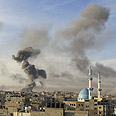
After eight days of intense aerial bombardments of terrorist infrastructure in the Gaza Strip, Israel agreed to an Egypt-mediated ceasefire, effectively marking the end of Operation Pillar of Defense. Despite the fact that over 70% of Israelis were against the ceasefire deal, the IDF raced to declare victory after the 9 pm deadline came into effect, touting its many, albeit minor, military achievements. And again, despite popular opinion, the IDF's case is strong.
Consider as a contrast the Second Lebanon War, widely perceived as a failure by the Israel public, and confirmed as such by the government-appointed Winograd Commission. In 2006, the IDF invaded Lebanon with a number of ambitious goals, including the toppling of Hezbollah and the engendering of long-term change in the Lebanese political system. Indeed, the loftiness of the goals rendered IDF action void ab initio, and doomed to insignificance even the military's considerable tactical victories.
Learning from its mistakes, for Operation Pillar of Defense the IDF set itself modest, achievable military goals. The first, tactical, was to deplete Hamas' stores of rockets and weapons systems.
The second, strategic, was to recreate a comprehensive deterrence capability that would cause terrorists in the coastal enclave to hesitate before renewing rocket salvoes against Israel's south.
According to the IDF, during the course of the eight-day operation, Israel targeted:
- 30 senior Hamas and Islamic Jihad terrorists
- 19 high-level command centers
- 980 underground rocket launchers
- 140 smuggling tunnels
- 66 tunnels used for terrorist operations
- 42 operation rooms and bases owned by Hamas
- 26 weapons manufacturing and storage facilities
To add a little bit of context, the IDF launched far more airstrikes in Gaza during the first few days of Operation Pillar of Defense than during the same initial period of Operation Cast Lead of 2008-2009. The recent operation decimated Hamas' and other terrorist organizations' stores of Qassam rockets and mortars, while all but completely obliterating their Iranian-made Fajr-5 missiles.
On the diplomatic front, if Israel secures Egyptian cooperation over weapons smuggling into Gaza, Hamas could find it exceedingly difficult to resupply and rearm. These represent incontestable tactical scores for the IDF, and could be considered, ipso facto, justification for Operation Pillar of Defense.
Which leads us to the IDF's deterrence capabilities: The IDF displayed the effectiveness of its budding UAV program, dubbed "Canopy of Fire," or hupat esh in Hebrew. The program is comprised of constant aerial surveillance of terrorist infrastructure in the Gaza Strip.
Buzzing drones flying kilometers above the enclave use high-resolution cameras to monitor individual terrorists conducting military operations, at times allowing the IAF to conduct rapid pinpoint strikes against the operatives. The program is increasingly successful, and will eventually threaten terrorists' ability to fire rockets into Israel without being targeted by an IAF strike.
Of course, the success of the operation will ultimately be judged in the coming weeks and months based on the stability of the ceasefire deal. If Israel has in fact managed to renegotiate the "rules of the game" to prohibit rocket fire on Israel's south, the operation will be deemed a success.
But be clear, there are very few within the IDF, if any, who believe that Operation Pillar of Defense is a long-term solution to Palestinian rocket fire. Most expect the ceasefire to break down eventually, as Defense Minister Ehud Barak said, within "nine days, nine weeks, or more."
Far from being a regional game-changer, the operation was viewed as a tactical necessity, one which has frustrated the increasingly brazen terrorist attacks emanating from Gaza, and which will have to be repeated in weeks, months, or years down the line.
It is viewed as both a sequel to Operation Cast Lead and a prequel to what will invariably be the next IDF operation in the Strip, and the next, until a diplomatic solution can be found.
In IDF slang, the process is known as "mowing the lawn." Only time will tell when the weeds will grow back.
Yoni holds a BA degree in Psychology with a minor in Political Science, from the University of British Columbia. He is currently working as a journalist in Israel, and his expertise lies in policy, conflict and Middle East affairs. Yoni was called up for reserve duty in the IDF's Strategic Division at the start of Operation Pillar of Defense.
















